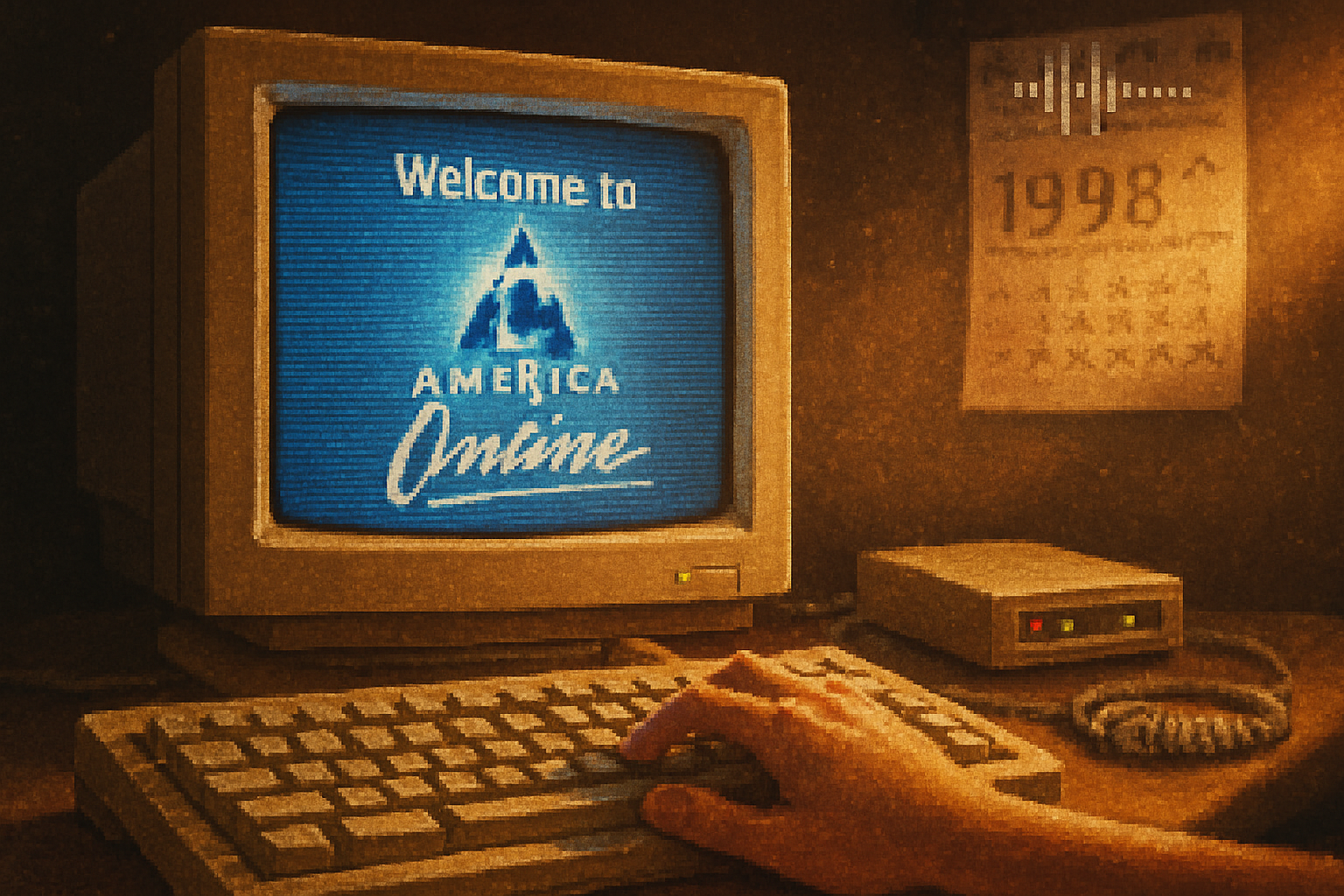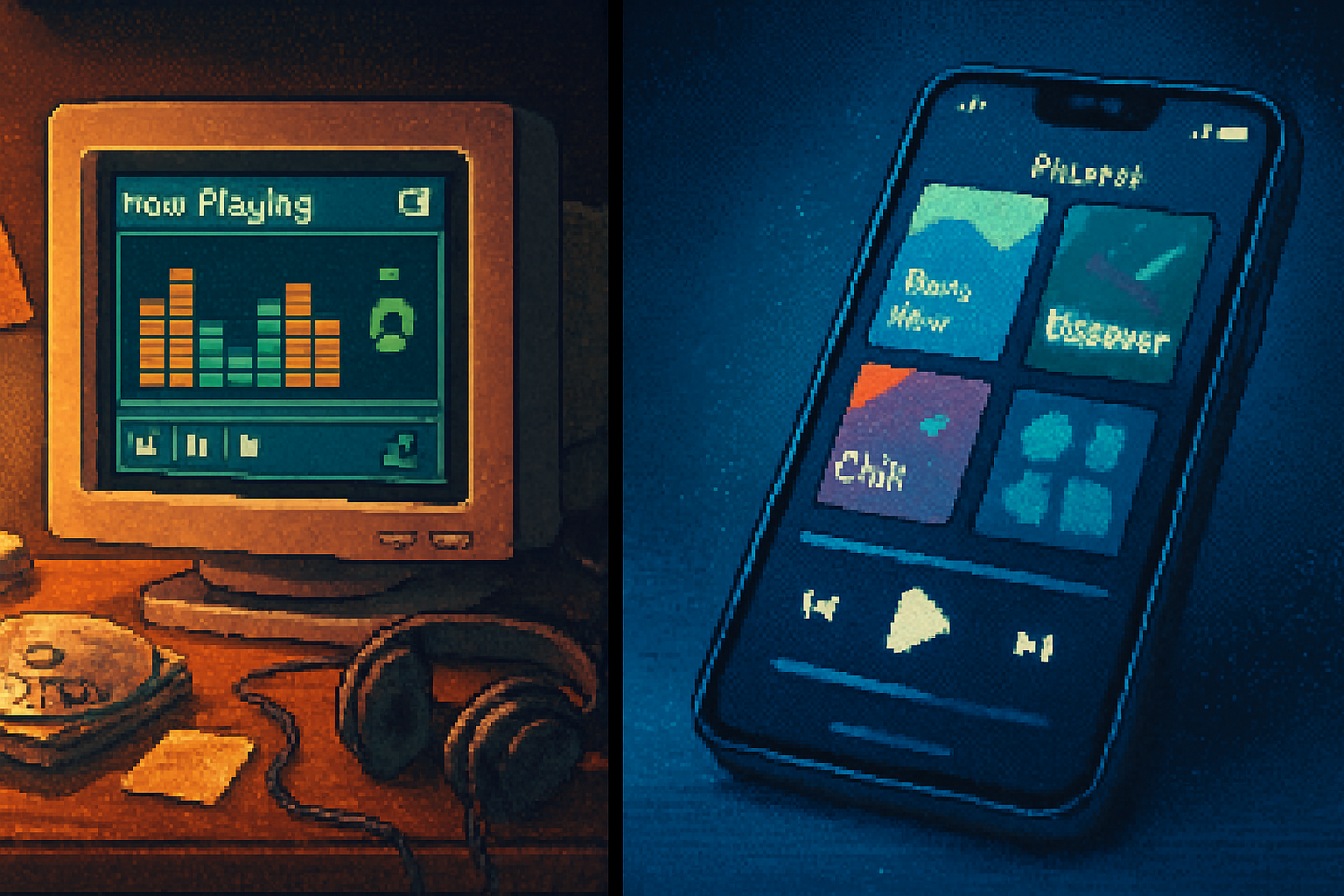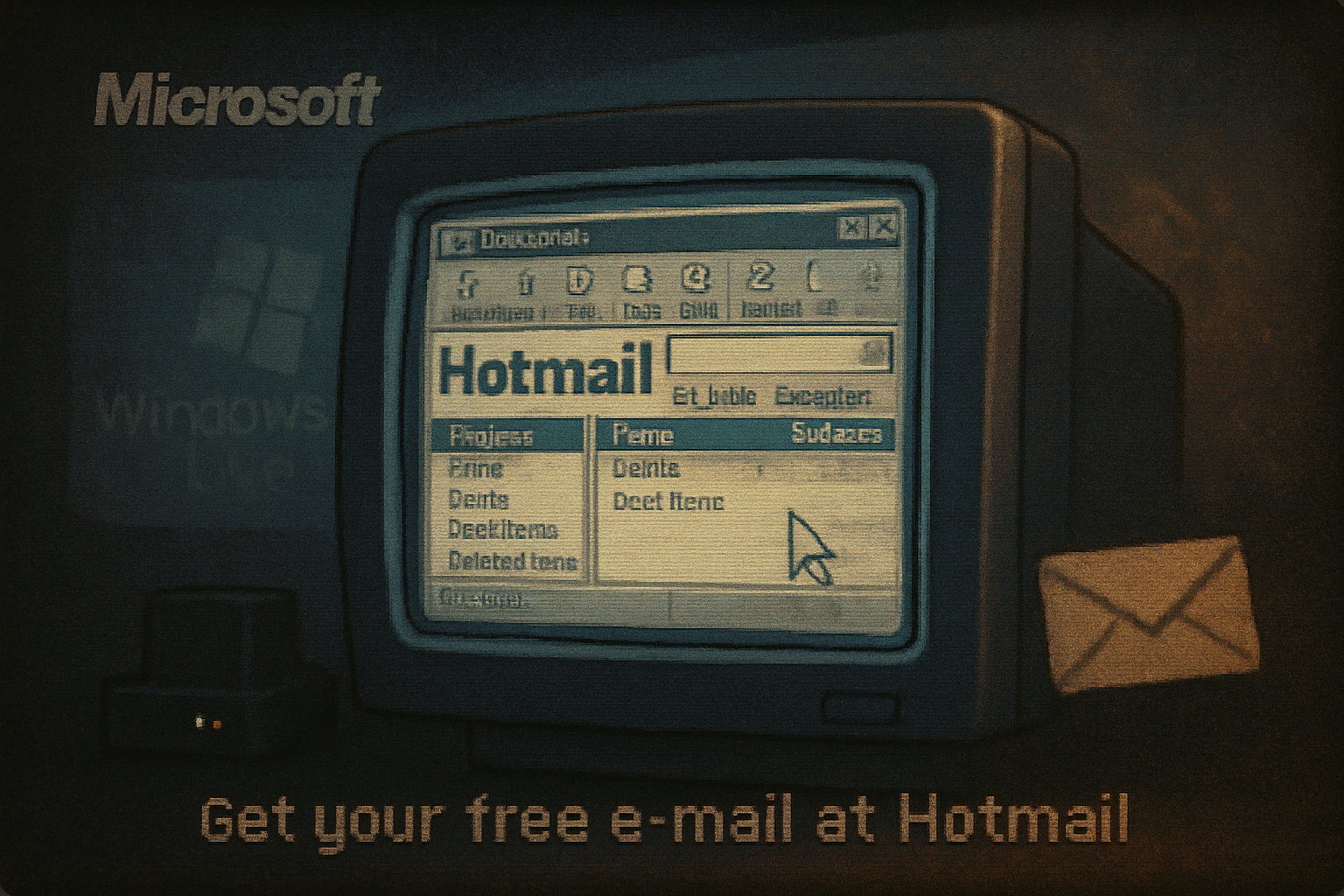· retrotech · 7 min read
The AOL Dial-Up Experience: A Soundtrack of the Past
A short, evocative exploration of how the squeal and stutter of AOL's dial-up shaped early internet identity. Featuring first-person recollections, a brief technical primer, and three curated playlists inspired by those unforgettable tones.

The night my family got broadband, I remember the silence more than the speed.
For years, the ritual that announced connection to the rest of the world was a tiny liturgy performed by a beige box and an even more beige cable: insert the AOL floppy or double-click the shortcut, hear the telephone line ring, and wait for the modem’s warble - a staccato negotiation that sounded like a fax machine learning Morse code while a robot gargled. Then, triumph. “You’ve got mail.” The room exhaled.
That clattering handshake was not just a technical handshake. It was a social one. A how-we-live-now click. It wired patience into our online selves and taught a generation to perform anticipation.
Why the sound mattered
If you’ve never heard a dial-up handshake, imagine a tiny, mechanical orchestra warming up for a show that might - if the stars and the telephone company aligned - begin in sixty seconds. That noise did several things at once:
- It announced presence. Somebody else was on the line. You were connected to someone beyond your wall.
- It normalized waiting. The internet demanded patience; the modem taught it.
- It created ritual. The sound punctuated evenings, homework sessions, and the occasional family argument about the phone line.
Briefly, how it worked: dial-up internet used the public telephone network to connect your modem to an Internet Service Provider’s modem. The two modems performed a tonal negotiation - frequency shifts and handshakes - to settle on a speed and compression scheme. It’s noisy because the conversation had to happen across an analog voice line designed for human speech, not binary packets.
For a compact technical primer, see the Wikipedia entry on dial-up internet access: https://en.wikipedia.org/wiki/Dial-up_Internet_access
Interviews: voices that remember the squeal
Below are edited recollections from three people who lived the dial-up era. These are their voices; they are also representative of thousands of similar small performances.
Mara, 39 - “I learned theater in a modem’s squeal”
“We treated the AOL screen like a stage. I’d hit connect, and while the modem did its thing, I’d rehearse what to type in the chat room. That fifteen seconds of wailing? It was like a curtain being drawn. People listened - neighbors would ask if I was ‘still on’ like it was a party. When it finally logged in, it felt like applause.”
Jamal, 45 - “The sound was both thrilling and infuriating”
“You were doing homework and had to wait for web pages to load like molasses. But the ritual made you care. The screech told you: you’re joining the world now. There was excitement - and the constant fear that someone would pick up the landline and ruin everything. That’s where my first real frustration with technology came from.”
Evelyn, 58 - “You’d argue over the line”
“My children would be on the AOL for hours. I could hear the modem. It made me know where they were - glued to the green text, somewhere else. I’d shout from the kitchen to hang up because we needed the phone. Sometimes it meant dinner was late. Sometimes it meant a fight. The sound is the sound of family economics.”
These recollections converge on two themes: the ritualization of connection and the social consequences (time, fights, patience). The sound was the broker of that liminal space between private life and an emergent public one.
The sound and online identity: screen names, rituals, and theater
Before social networks gave us curated feeds and algorithmic reinforcement, identity was a dress-up game conducted in bits and beeps. The dial-up era taught us a few habits:
- Screen names as stage names. Choosing an AOL handle was an intentional act - a first impression made before your avatar, before your photo. You waited for the modem to connect as you considered who you wanted to be online.
- Presence as performance. Waiting for connection made you more deliberate. When you finally arrived in chatrooms, your words had weight precisely because they had been delayed.
- Patience as scarcity. The constraint of time (limited minutes on the phone line, slow page loads) made certain kinds of interactions rare and therefore more valued.
In short: the modem’s wy-and-wail conditioned social attention. It taught us to savor arrivals and regard digital presence as occasional and announced, not continuous and presupposed.
Playlists inspired by the dial-up
Below are three curated playlists - not literal reproductions of modem noise, but emotional mappings. Think of them as soundtracks for the stages of a dial-up session.
Playlist 1 - The Handshake (Tension & Anticipation)
- “Toccata and Fugue in D Minor” - J.S. Bach (for the dramatic opening)
- “Come As You Are” - Nirvana (a slow, expectant entry)
- “Waiting Room” - Fugazi (literal waiting; clipped urgency)
- “The National Anthem” - Radiohead (static, building)
- “Breathe” - The Cinematic Orchestra (release)
Why: These tracks move from anxious, punctuated opening notes to a release - mirroring the modem’s escalation and the eventual connection.
Playlist 2 - You’ve Got Mail (Triumph & Everyday Wonder)
- “You’ve Got Mail” - frank musical nods and jingles (think small triumphant synths)
- “Here Comes the Sun” - The Beatles (soft optimism)
- “Send Me On My Way” - Rusted Root (impish joy)
- “Stereo Love” - Edward Maya & Vika Jigulina (synth hook; modern nostalgia)
- “Home” - Edward Sharpe & The Magnetic Zeros (reunion energy)
Why: This is the post-handshake playlist - the little private victory lap after connection.
Playlist 3 - The Hang-Up (Frustration & Loss)
- “I Can’t Get No Satisfaction” - The Rolling Stones (obvious)
- “Every Breath You Take” - The Police (anxious obsession)
- “Signal to Noise” - Peter Gabriel (static textures)
- “Disconnect” - Clean Bandit & Marina (thematically on the nose)
- “No Surprises” - Radiohead (quiet despair)
Why: The modem dropping the call, the neighbor picking up the phone, the page that never fully loaded - these songs hold space for irritation and rueful humor.
If you want to assemble these into actual playlists, search these tracks on your preferred streaming service and order them according to the sections above.
Recreating the sound: a quick DIY for the nostalgic
If you want to sample the sound (for art, a podcast, or because you miss it), here’s a simple, legal way:
- Search for “AOL dial-up sound” on a public audio/video sharing site (for example: https://www.youtube.com/results?search_query=aol+dial+up+sound).
- Use an audio editor (Audacity is free) to import the clip and trim to the handshake portion.
- Apply light compression and EQ to emphasize the squawks and reduce background hiss.
- Loop or time-stretch as desired. A short loop of the handshake played under a monologue instantly situates the listener in 1998.
(Respect copyright: use clips only where you have the right to do so, or for private, non-commercial nostalgia.)
Why we still care
We remember the sound because it was an audible boundary between two worlds: the house and the internet, the now and the not-yet. Today’s always-on connectivity removed the ritual. Connection became invisible, which solved one set of problems and created another: attention sapped by constant presence.
The AOL handshake was a primitive but useful affordance. It made connection a moment worth noticing. It enforced a kind of digital etiquette because the phone line was a shared and scarce resource. That scarcity taught manners. It taught longing.
It taught identities, too. The pause before “You’ve got mail” was a breathing space we used to arrange ourselves. We logged on, performed, and left traces - little online selves that survive in old profile names, in memories, and occasionally in a forgotten AIM handle still registered somewhere.
Closing: the sound as a small sacrament
The modem’s wail was ridiculous. It was also ritualistic, like a town bell announcing news: someone has arrived. We laugh now at the tinny, primitive song of the handshake. But laughter has an edge of tenderness. The sound was a soundtrack for a transitional public - half-offline, half-connected - taught to move between spaces with the patience of people who once waited.
If you hear that noise again, you’ll find it’s more than static. It’s a memory in stereo: annoyance and pride, impatience and ceremony, all squeezed into sixty seconds of analog negotiation. It was the sound of the world getting smaller and of our imaginations getting larger.
Sources and suggested further listening
- Dial-up internet access (technical background): https://en.wikipedia.org/wiki/Dial-up_Internet_access
- If you want to hear the original - search “AOL dial-up sound” on public audio/video platforms:



